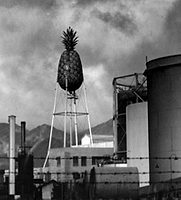The pineapple

My first office space was in the old American Can Company Warehouse, also known as the 1928 building (built in 1928) in the Dole Cannery Complex. The address was 720 Iwilei Road. Our tiny 520 square foot office was located on the fourth floor, accessible by two ancient freight elevators; you know, the ones with manually operated doors and gate. One cool thing about our location was that it was in shadow of what was one of the most significant landmarks in Honolulu, a water tower that looked like a pineapple.
In 1927, the Hawaiian Pineapple Co. (HPC), later to become Dole Pineapple, undertook a major expansion of its processing plant, located in the Iwilei section Honolulu. The expanded plant and its several new buildings eventually covered a total area of 19 acres. Of course, a reliable water supply was needed for the many new automatic sprinkler systems. As part of that water supply, a new water tank would be constructed. The tank was designed by HPC Engineer Simes Thurston Hoyt.
The architect in charge of the expansion project was famed Hawaii architect Charles William (C. W.) Dickey. Of interest is that Dickey was the brother-in-law of James Dole, the Pineapple King, founder of the Hawaiian Pineapple Company. Dickey is known for defining the Hawaiian style of architecture that has held sway through the present day.
In a moment of inspiration, Dickey proposed that the tank was built to resemble a pineapple. The rest is history.
Engineer Hoyt developed the tank design and contracted its manufacture to the Chicago Bridge and Iron Co. (CB&I) factory in Greenville, Penn. The tank was shipped to Honolulu in three pieces. The Watertower, Chicago Bridge and Iron's newsletter, predicted the tank would, "no doubt be one of the important objects of interest to visitors at Honolulu."
The Pineapple made CB&I famous and started a trend. CB&I later built other product based water tanks including the Gerber Baby Food Jar in Rochester, N.Y., and the Sir Walter Raleigh Tobacco Can in Louisville, Ky.
Erection of the tank was completed in January of 1928. The tank measured 24 feet in diameter and 40 feet in height. It was placed on a 100 feet tall steel structure. When the delicate leafy crown and red aircraft beacon were placed, the Pineapple Water Tank stood out as the tallest structure in Honolulu.
For us fire folks, the tank’s design gives us a glimpse of early fire sprinkler design and installation.
In 1927, the design of sprinkler systems for a manufacturing plant was likely based on the 1926 edition of NFPA 13. Sizing of sprinkler system piping was according to the "1-2-3" pipe schedule, introduced with the 1905 edition of NFPA 13. The "1-2-3" designation indicated that a 3/4-inch pipe could supply one sprinkler, a 1-inch pipe could supply two sprinklers, 1 1/4-inch pipe could supply three sprinklers, and so on. This pipe schedule remained unmodified until 1940, at which time the use of 3/4-inch steel pipe in a pipe schedule system was prohibited and the schedule became known as ordinary hazard pipe schedule. It is noted that with the 1931 edition of NFPA 13 the "1-2-3" pipe schedule become known as the Class A sprinkler system. This was done to distinguish it from the newly established Class B system. The pipe schedule for Class B systems was modified in 1940, and became the light hazard pipe schedule.
It is safe to assume that the buildings at HPC were protected by the "1-2-3" pipe schedule systems (ordinary hazard). Now, let us assume the water supply requirements for pipe schedule systems were the same as those of today and that ordinary hazard sprinkler systems at the plant protected buildings of both combustible and noncombustible construction. Let us further assume the sprinkler systems were supervised by plant personnel. Then it would be reasonable to establish the water supply requirements at a flow of 1,500 gpm for 60 minutes for a minimum total capacity of 90,000 gallons (see Table 11.2.2.1 of NFPA 13, 2013 edition). That would explain why the pineapple tank was sized to hold 100,000 gallons of water.
The American Can Company Warehouse, where my office was located, had such a "1-2-3" pipe schedule sprinkler system, complete with 3/4-inch steel pipe. The building had 13-foot-high ceilings, perfect for storing pallet loads, two or three high, of the empty tin cans for holding those juicy circular slices of pineapple. Another interesting thing about this system is that the installers took full advantage of the NFPA 13 provisions allowing the bending of steel pipe. Another thing that always amazes me about the sprinkler system is those eight-inch diameter threaded tees. The fitters in those days must have really had some.
Sprinkler protection was not only provided for process and storage buildings, the well-appointed headquarters building was also protected. Grinnell quartzoid sprinklers, the first glass bulb sprinkler, shown in the photo, were originally installed in the main entrance lobby of the HPC headquarters office building. The sprinklers were ornately adorned with lead attachments coated in gold leaf (not sure if that came with a listing).
Now, let us get back to the water tank. For more than 60 years, the Dole cannery was a major place of summer employment for island teenagers. Virtually, everyone that lived in Honolulu that is over 50 years old spent one or more summers working in the plant, either on the assembly line or prepared product to enter the line. To them, working underneath the water tank was an integral part of this rite of passage to the work force.
To many other locals, the tank was like an old-time GPS. For decades, locals used the landmark as a point of reference for giving directions and for getting around Honolulu. For the first several years in my office on Iwilei Road, barely a week went by when I used the tower to help clients find our location. Nobody knew where Iwilei Road was, but everyone knew where the Pineapple was.
Unfortunately, shortly thereafter, things started to change. Since 1968, land in central Oahu, once used to cultivate pineapple land, was being used for the development of the bedroom community of Mililani. Pineapple production on Oahu began a steady decline. Finally, the Iwilei cannery ceased operations in 1992. Along with this, the Pineapple Water Tank, the largest pineapple in the world, that Honolulu icon for 65 years, had gotten old. In 1993, the rusting tank and tower were taken down. The tank was “stored” in its original three pieces. It was treated like that once favorite toy that the child had tired of. Sitting in a vacant lot at the Cannery, it continued to corrode, eventually rusting into oblivion. I had not been so saddened by the loss of an inanimate object since the Washington Senators fled to Texas after the 1971 season. I can only imagine what thousands of locals must have felt when the water tower was destroyed.
Now, when someone wants to know how to get to our new office (which is in a different building on the old HPC site) I give them directions but they still get lost. I insist that it is not due to the quality of my directions, but is due to the fact that there is no giant pineapple to point the way.
There was “sort of” a promise to restore the tank, but it was “sort of” not kept.
For the second time in a few months, I feel the urge to quote a Joni Mitchell lyric in this column, "Don't it always seem to go, that you don’t know what you got till it’s gone."
I guess that old pineapple took a ride in that Big Yellow Taxi in the sky. n
Samuel S. Dannaway, PE, is a registered fire protection engineer and mechanical engineer with bachelor’s and master’s degrees from the University of Maryland Department of Fire Protection Engineering. He is past president and a Fellow of the Society of Fire Protection Engineers. He is president of S. S. Dannaway Associates Inc., a 15-person fire protection engineering firm with offices in Honolulu and Guam. He can be reached via email at SDannaway@ssdafire.com.





